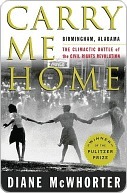More on this book
Kindle Notes & Highlights
Read between
July 3 - August 2, 2020
It was almost as if the bureau shared the reasoning advanced by Eastview’s Billy Holt in his FBI interview. The burning of the bus at Anniston—a property crime—was “a terrible thing,” while the Freedom Riders beaten in Birmingham “got what they deserved.”
John Lewis, the SNCC leader from Nashville via Troy, Alabama, who was the only current rider who had been in the original CORE crew, debarked with Birmingham’s Catherine Burks onto the loading dock. As they talked into the NBC cameras, a hundred white men and women surged around the bus, swinging metal pipes, sticks, bats, and pocketbooks.
One of the “two niggers” was John Lewis, who had been brained by a wooden crate. A car driven by the Sullivan judge, Walter B. Jones, pulled up next to Lewis. The attorney general of Alabama, MacDonald Gallion, got out of it and dodged a flying Coke bottle in order to serve Lewis with Jones’s injunction barring integrated bus riding in Alabama.
George Wallace and Jim Simpson, embrace around the emotional essence of segregation, racism. The consolation for Simpson’s corporate constituents was that the balm Wallace was offering Alabama’s poor was race hate rather than the old panacea of “redistribution of the wealth.”
A long section on how the civil rights movement would also liberate the white man was cut, as was a discussion of how it would enhance U.S. moral authority in the Cold War.
As CBS’s Dan Rather said in summing up the effectiveness of the demonstrations, “This country will tolerate almost anything as long as you don’t block traffic.”
At any rate, Lingo had no law enforcement experience—he was a cabinetmaker, specializing in doors, who had piloted Wallace’s campaign plane. The main qualification for his current job was the vulgarity with which he expressed his views of Negroes.
The troopers were Birmingham’s newest wave of “outside agitators.” They acted out the segregationist brutality that the white South could no longer get away with,
The murder of Virgil Ware would be submerged in the tragedy of the white Eagle Scouts—“these two raw, grieved untutored boys, who have had this unfortunate thing come into their lives at their age,” as their attorney, Roderick Beddow, the best criminal lawyer in the city, would describe them. Larry, the murderer, would be sentenced to six months in a juvenile detention center, and Michael got probation.
Johnnie Robinson, a black sixteen-year-old, was shot in the back by Officer Jack Parker as he ran up a downtown alley after throwing rocks at a car shoe-polished with such messages as “Negro, go back to Africa.”
The country’s Cassandra on the race front, James Baldwin,
It sometimes seems that the struggle for black equality in America is Sisyphean.
Congressman John Lewis, who had met Shuttlesworth as a Freedom Rider more than half a century earlier, called him “one of the founding fathers of the new America.”


